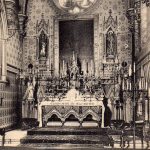St Mary’s Roman Catholic Church, Ryde

St Mary’s Roman Catholic Church in High Street, Ryde, was built at the sole expense of The Right Honourable Elizabeth Julia Georgina, Countess of Clare. She had moved to Ryde to be near her brother, The Honourable Lindsay Burrell, a keen sailor and a founder member of the Royal Victoria Yacht Club, after separating from her husband, John Fitzgibbon, 2nd Earl of Clare.
Once established in Ryde she began to attend services at the Anglican Church of St James’ in Lind Street, where the Rev Richard Waldo Sibthorp MA was incumbent. Here she was to witness a church service far different to those she had attended before, as Rev Sibthorp’s services, which had already started to cause concern to the members of The Protestant Society in the town, gradually became a mixture of Roman Catholic and Anglican doctrines. He eventually left St James’ in 1841 to become a Roman Catholic.
The Countess was very interested in the Catholic faith as she searched for a belief she felt was more in keeping with the teachings of the early Fathers of the Church. With her companion Charlotte Elliot, she travelled to Europe to visit the churches and cathedrals of Catholic Europe to learn more.
She was stunned by the beautiful and imposing cathedrals she visited on her journey, and when she finally reached Rome, she was thrilled to be in the Eternal City with its stunning art and architecture.
It was here she met Thomas Grant, who was later to become the Bishop of Southwark, from The English College, who gave her instruction in the Catholic Faith. He later introduced her to Father William Hunt who became the Provost of Westminster, and he received her into the Catholic Church in St Peter’s Basilica, Rome, on 7 September 1841.
When she returned to Ryde, the Countess attended Mass at St Thomas of Canterbury Church in Newport. She realised there was a need for a church in Ryde as not everyone could travel the seven miles to Newport in a pony chaise as she could; others had to walk.
At first, the small Roman Catholic community in the town attended Mass at a small villa in Goldsworth Grove (between West Street and Victoria Street) conducted by the recently ordained Father Thomas Richardson. The Countess wanted to build a fine church to reflect the importance of her conversion, and when a plot of land in the High Street came up for auction she was determined to acquire it.
A gardener, Mr Mayne, was asked to bid for the plot on her behalf, as there was still a lot of unrest among The Protestant Society in the town due to the “Sibthorp affair”. The Countess engaged Joseph Aloysius Hansom, of Hansom Cab fame, as architect. Initially he wanted to design a Classical style church but on seeing the High Street plot, he decided an Early English Gothic design was more in keeping with the surroundings.
Once Bishop Griffiths of the London District, and the relevant officials in Rome had accepted the plans, Thomas Dashwood, a local builder was employed to carry out the project.
The foundation stone was laid by Father John Clark of Gosport, (representing Bishop Griffiths), together with Father Thomas Fryer of Newport, and Father Thomas Richardson of Ryde, on the third Sunday of Advent, 17 December 1844. The Church opened 18 months later. It is built in local ragstone with Caen stone dressing on the west front and has many fine features including the tomb-shaped High Altar, a replica of the one in York Minster, York.
The first Low Mass was said on Trinity Sunday, 7 June 1846 before all the building works were completed. Father William Hunt who had baptised the Countess into the Catholic faith in Rome conducted the service in the south aisle (now the Lady Chapel). Newly appointed rector, Father John Telford, had advised this Mass should be a quiet affair because of the continued hostility towards Catholics, and the recent death of Pope Gregory XVI.
Later in the year, when the internal furnishings of the Church were completed, Father John Clark of Gosport celebrated a High Mass on 22 September with Father John Telford and Father William Hunt. The Countess would hear Mass in her own private chapel situated above the sacristy. The first Episcopal visit took place on 27 June 1847, when Bishop Thomas Griffiths confirmed 92 people.
Monsignor Thomas Grant, the first Bishop of Southwark, consecrated the Church to the glory of God and in honour of the “Immaculate Heart of Mary for the conversion of sinners” on 21 May 1863. The Church has beautiful stained glass windows that were added between 1860 and 1880. The Lady Chapel and Shrine of Our Lady in the southeast corner were built in 1893. The shrine has an altar designed by Augustus Welby Pugin with a carving of Our Lady of Walsingham and beautiful murals of various decades of the rosary.
In the 1850s the Countess’s generosity also provided St. Mary’s School, (now the parish hall) paying the salary of two teachers and a row of cottages in St Mary’s Passage for church workers.
Excerpt from RSHG’s book Ryde’s Heritage: Our Town, Your Histories published June 2008
- St Mary’s Roman Catholic Church interior

